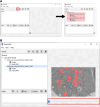DeepSCEM: A User-Friendly Solution for Deep Learning-Based Image Segmentation in Cellular Electron Microscopy
- PMID: 40888071
- PMCID: PMC12400132
- DOI: 10.1111/boc.70032
DeepSCEM: A User-Friendly Solution for Deep Learning-Based Image Segmentation in Cellular Electron Microscopy
Abstract
Deep learning methods using convolutional neural networks are very effective for automatic image segmentation tasks with no exception for cellular electron micrographs. However, the lack of dedicated easy-to-use tools largely reduces the widespread use of these techniques. Here we present DeepSCEM, a straightforward tool for fast and efficient segmentation of cellular electron microscopy images using deep learning with a special focus on efficient and user-friendly generation and training of models for organelle segmentation.
Keywords: cellular imaging; deep learning; electron microscopy; organelles; segmentation; software.
© 2025 The Author(s). Biology of the Cell published by Wiley‐VCH GmbH on behalf of Société Française des Microscopies and Société de Biologie Cellulaire de France.
Conflict of interest statement
The authors declare that they have no conflict of interest.
Figures







Similar articles
-
mEMbrain: an interactive deep learning MATLAB tool for connectomic segmentation on commodity desktops.Front Neural Circuits. 2023 Jun 15;17:952921. doi: 10.3389/fncir.2023.952921. eCollection 2023. Front Neural Circuits. 2023. PMID: 37396399 Free PMC article.
-
Modular segmentation, spatial analysis and visualization of volume electron microscopy datasets.Nat Protoc. 2024 May;19(5):1436-1466. doi: 10.1038/s41596-024-00957-5. Epub 2024 Feb 29. Nat Protoc. 2024. PMID: 38424188 Review.
-
Automated segmentation of hyperreflective foci in OCT images for diabetic retinopathy using deep convolutional networks.Appl Opt. 2025 Apr 20;64(12):3180-3192. doi: 10.1364/AO.547758. Appl Opt. 2025. PMID: 40792842
-
Automated rating of Fazekas scale in fluid-attenuated inversion recovery MRI for ischemic stroke or transient ischemic attack using machine learning.Sci Rep. 2025 Sep 1;15(1):32219. doi: 10.1038/s41598-025-17287-5. Sci Rep. 2025. PMID: 40890345 Free PMC article.
-
Advancements in automated nuclei segmentation for histopathology using you only look once-driven approaches: A systematic review.Comput Biol Med. 2025 May;190:110072. doi: 10.1016/j.compbiomed.2025.110072. Epub 2025 Mar 25. Comput Biol Med. 2025. PMID: 40138968
References
-
- Chaurasia, A. , and Culurciello E.. 2017. “LinkNet: Exploiting Encoder Representations for Efficient Semantic Segmentation.” 2017 IEEE Visual Communications and Image Processing (VCIP) , 1–4. 10.1109/VCIP.2017.8305148. - DOI
MeSH terms
LinkOut - more resources
Full Text Sources

